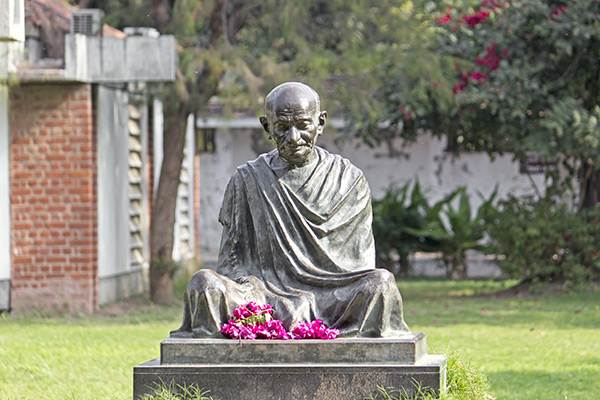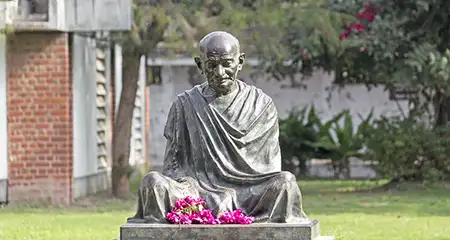For Indians, young or old, the name Sabarmati Ashram needs no introduction. Also known as Gandhi Ashram, it is located on the banks of the River Sabarmati, about 6 km away from the heart Ahmedabad. The ashram holds the honor of being the residence of Mahatma Gandhi from 1917 and 1930 and an epicenter of Indian freedom struggle. It also served as the base for many of his activities including the iconic Dandi March of 1930. Currently, the ashram complex houses a museum where you can see many of Gandhiji’s letters and belongings on display, and several other establishments and structures. Needless to say, it is one of the top tourist places to visit in Ahmedabad.
So, how about taking a walk down the lane of India’s freedom struggle? Here’s everything you should know about Sabarmati Ashram, Ahmedabad such as its history, timings, entry fee, attractions, and more.
Sabarmati Ashram, Ahmedabad Information
| Type | Historical building/ complex |
| Status | Monument of National Importance |
| Also Known as | Gandhi Ashram, Harijan Ashram, and Satyagraha Ashram |
| Established by | Mahatma Gandhi |
| Year of Establishment | 1917 |
| Location | Ashram Road |
| Distance from Major Transportation Hubs | Ahmedabad Airport (8 km); Ahmedabad Junction (6 km) |
| Nearest Bus Stop | Gandhi Ashram Bus Stop |
| Timings | 8:30 am to 6:30 pm; every day including public holidays |
| Entry Fee | Free |
| Videography and Photography | Free |
| Key Attractions | Gandhi Smarak Sangrahalaya or Gandhi Memorial Museum, Magan Niwas, Vinoba-Mira Kutir, Hriday Kunj, Nandini, Udyog Mandir, Upasana Mandir, Somnath Chhatralaya, etc. |
Sabarmati Ashram, Ahmedabad: History
Did you know that Sabarmati was not the first ashram Gandhi established in India after returning from South Africa? In 1915, he built his very first ashram in a bungalow in the Kochrab area which was gifted to him by one of his barrister friends. He wanted to carry out activities such as animal husbandry, farming, and khadi but the Kochrab Ashram wasn’t big enough for such pursuits. So, in 1917, the ashram was relocated to a 36-acre open land located on the banks of the Sabarmati and later, it came to be known as Sabarmati Ashram. It was also known by other names such as Gandhi Ashram, Harijan Ashram, and Satyagraha Ashram.
History has it that Gandhiji lived in this ashram from 1917 until 1930 and he also started a school within the complex to give training in agriculture, manual labor, and literacy. What’s more, it was from here that he and 78 of his companions started the Dandi march in 1930 to protect the Salt Law imposed by the British. A massive civil disobedience movement ensued and the British government seized the ashram. In 1933, he disbanded the ashram in support of the freedom fighters and also swore not to return to it till India gained independence. Although the country became free in 1947, Gandhiji could never return to the ashram as he was assassinated in less than 6 months.
Sabarmati Ashram, Ahmedabad: Today
As the ashram was one of the epicenters of the country’s freedom movement, the government of India declared it as a Monument of National Importance. A museum named Gandhi Smarak Sangrahalaya was built within the ashram complex to preserve the works and memory of Gandhiji. In addition to this, it houses other institutions, structures, and a guesthouse and the ashram also conducts events to promote Gandhian ideology. Special events are held here on occasions related to Gandhi’s life and India’s freedom struggle. Today, Sabarmati Ashram serves as a top tourist attraction and one of the major historical places to visit in Ahmedabad.
Gandhi Smarak Sangrahalaya or Gandhi Memorial Museum
The Gandhi Smarak Sangrahalaya or Gandhi Memorial Museum is one of the key attractions for history buffs visiting the ashram. The museum was designed by Charles Mark Correa, a famous Indian architect, and was inaugurated in 1963 by Jawaharlal Nehru. It houses the following sections and exhibits:
- Gandhi in Ahmedabad Gallery: It consists of about 50 hand-drawn panels depicting the major events in Gandhiji’s life from 1915 to 1930.
- My Life is My Message Gallery: It displays over 250 photographs that chronicle the life of Gandhiji – from his birth in Porbandar and the time he spent in England and South Africa to the freedom movement and his tragic assassination.
- Painting Gallery: It houses 8 life-size portraits each of which depicts Gandhiji doing various activities such as marching, meditating, spinning cloth, etc.
- Library and Archives: These sections contain a sizeable collection of exhibits including 34,111 letters, 1,371 manuscripts, 210 films in English, Hindi, and Gujarati languages, 612 audio cassettes, 106 video cassettes, 50, 000 books, 6,000 photo negatives, and the personal diary of Gandhiji.
- Museum Shop: This is an in-house souvenir store where you can buy books and memorabilia such as postcards, charkha models, keychains, pen drives, stationery, statues, etc.
Things to See in the Sabarmati Ashram Complex, Ahmedabad
Once you have explored the museum and its exhibits, set out to explore the other sites and structures within the compound. The most important things to see in Sabarmati Ashram, Ahmedabad include:
- Magan Niwas, the hut or cottage where Maganlal Gandhi, a true follower and the nephew of Gandhiji, lived. He also served as the manager of the ashram till his death in 1928.
- Hriday Kunj, the house where Gandhiji and Kasturba Gandhi lived from 1917 to 1930. The house features 6 rooms and some of his belongings like writing desks and spinning wheels.
- Vinoba-Mira Kutir, a cottage where Acharya Vinoba Bhave stayed from 1918 and 1921. Later, it was the residence of Mirabehn, one of the most notable disciples of Gandhiji.
- Nandini, the old guesthouse where many prominent personalities including Jawaharlal Nehru, Rabindranath Tagore, Reginald Reynolds stayed during their visit to the ashram.
- Udyog Mandir, which was founded during the Ahmedabad Mill Strike of 1918. It played a major role in spreading the message of ‘Swaraj through Khadi’ and Gandhiji also lived in one of the small rooms of this building for a short period.
- Somnath Chhatralaya, a large building consisting of about 100 rooms. Back in those days, it was a community living quarters where participants of training programs and students of the ashram school used to stay.
- Upasana Mandir or Prarthana Bhoomi, an open prayer area where congregational prayers were conducted every morning and evening. It was also the site where Gandhiji used to give his sermon on the Bhagavad Gita.
Read also – Things to Do in Ahmedabad
Lesser-known Facts about Sabarmati Ashram, Ahmedabad
- At the time of its establishment, the land chosen for the ashram was located between a prison and a crematorium. Interestingly, Gandhiji was of the belief that a true satyagrahi will end up in either one of these places.
- Legends have it the ashram was built on the site where the ancient saint Dadhichi used to live. He is believed to have sacrificed his life so that the devas could make the ‘Vajra’ weapon using his bones to defeat the asuras.
- The Painting Gallery at the museum houses a unique portrait of Gandhi created using peanut shells. Shri Rajkishore Kapoor, the artist of this portrait, achieved a detailed and accurate rendition of Gandhi by heating these shells in varying temperatures.
Attractions near Sabarmati Ashram, Ahmedabad
- Sardar Vallabhai Patel National Memorial (3.5 km)
- Shri Swaminarayan Temple (3.5 km)
- The Calico Museum of Textiles (4 km)
- Hutheesing Jain Temple (4 km)
- Law Garden (5 km)
- Amdavad Ni Gufa (5 km)
A visit to Sabarmati Ashram will invariably take you back to the era of India’s freedom struggle. Walk around the place, get a glimpse into Mahatma Gandhi’s glorious life, and make a donation, if you feel like, towards the activities carried out by the ashram. While here, don’t forget to pay your respects to Bapu who continues to live among us through his works and ideology. Read also – Weekend Gateways from Ahmedabad




























